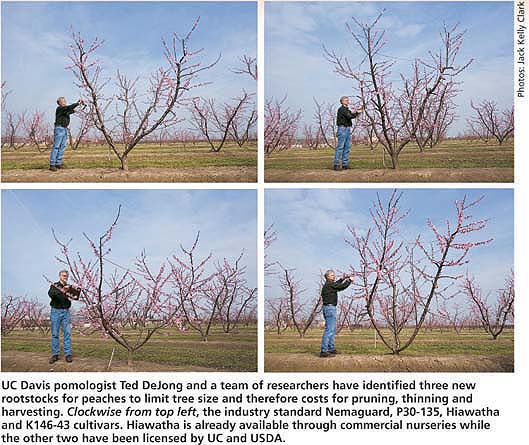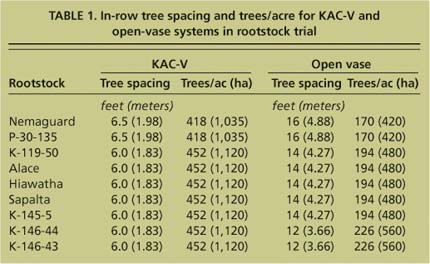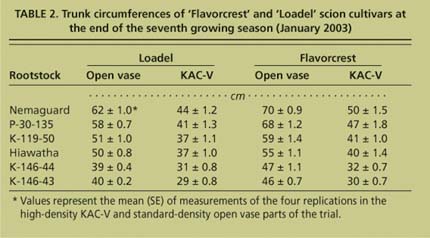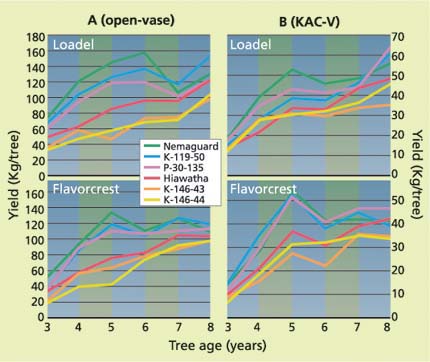All Issues
Labor costs may be reduced …
Publication Information
California Agriculture 59(2):80-83. https://doi.org/10.3733/ca.v059n02p80
Published April 01, 2005
PDF | Citation | Permissions
Abstract
Production costs in peaches are highly dependent on the cost of labor to prune, thin and harvest trees—costs that would drop if growers had rootstocks that decreased tree size. Collaborating researchers from UC Davis and the U.S. Department of Agriculture's (USDA) Horticulture Crops Research Laboratory in Parlier screened several promising clonal, size-controlling rootstocks for California peach production. In field tests, two peach scion cultivars (‘Flavorcrest’ and ‘Loadel’) on five interspecific hybrid rootstocks yielded positive results. After 8 years in the orchard, they performed well compared with trees on ‘Nemaguard’ rootstock (the California standard for peaches), with reduced trunk circumferences (60% to 95%), reduced dormant (22% to 80%) and summer (40% to 80%) pruning weights, and acceptable fruit size and crop yields (54% to 98%), since smaller trees will be planted at higher densities. This project has identified three new dwarfing rootstocks with commercial potential for California peach production. One rootstock (‘Hiawatha’) is already available through commercial nurseries and UC and USDA have jointly licensed the two others for commercial use.
Full text
The annual production costs for peaches grown in California are heavily dependent on the costs of hand labor for pruning, fruit thinning and harvest, which is often done from ladders because of large tree sizes (DeJong et al. 1999). It is widely recognized that production costs could be substantially decreased if the size of peach trees were reduced enough to eliminate the need for ladders. Such benefits have been clearly demonstrated with apples; the availability of commercially acceptable size-controlling or “dwarfing” apple rootstocks has revolutionized that industry (Webster 2001).
UC Davis pomologist Ted DeJong and a team of researchers have identified three new rootstocks for peaches to limit tree size and therefore costs for pruning, thinning and harvesting. Clockwise from top left, the industry standard Nemaguard, P30–135, Hiawatha and K146–43 cultivars. Hiawatha is already available through commercial nurseries while the other two have been licensed by UC and USDA.
Until recently, the primary factor limiting the widespread use of size-controlling rootstocks for peach (Prunus persica L. Batsch) production was the lack of commercially acceptable rootstocks compatible with a broad range of scion cultivars (Rom and Carlson 1987). In 1986, a rootstock screening experiment for peaches and plums was initiated at the UC Kearney Research and Extension Center (KREC). More than 120 Prunus genotypes from a range of genetic backgrounds were evaluated for their ability to root from hardwood cuttings, size-controlling characteristics and compatibility with peach (‘O’Henry’) and Japanese plum (‘Santa Rosa’). At the conclusion of that experiment, we selected 19 size-controlling rootstocks as having commercial potential for California peach production. In 1996, a second trial involving the most promising eight (based on ease of propagation and consistency of tree characteristics) of those 19 rootstocks was initiated to test their growth and production characteristics under semicommercial field conditions.
Rootstock field trial
In February 1996, a rootstock field trial was established at KREC. The research block consisted of two peach scion cultivars, ‘Loadel’ (clingstone) and ‘Flavorcrest’ (freestone), June-budded onto eight experimental and two control rootstock genotypes. The rootstocks tested were Alace, Hiawatha, Sapalta (open-pollinated seedlings of Sapa, a Prunus besseyi x P. salicina hybrid), K-145–5, K-146–43, K-146–44, P-30–135 (P. salicina x P. persica hybrids), K-119–50 (P. salicina x P. dulcis hybrid) and two control rootstocks, Citation (P. salicina x P. persica) and Nemaguard (P. persica x P. davidiana, the California standard). In all, we planted 36 trees of each rootstock/scion combination in two different training systems. Four replications of five trees each were planted and trained to the two-scaffold KAC-V system (DeJong et al. 1994), and four replications of four trees each were planted and trained to the standard multiscaffold open-vase system (Micke et al. 1980) ( see page 75 ). Between-row spacing was 16 feet (4.88 meters) for all rootstock/scion/training-system combinations, but in-row spacing varied according to expectations of the final tree size (table 1).
TABLE 2. Trunk circumferences of ‘Flavorcrest’ and ‘Loadel’ scion cultivars at the end of the seventh growing season (January 2003)
We randomized replication of the rootstock/scion combinations within training-system/scion cultivar subplots. In-row tree spacing between replications in the open-vase system was the shortest tree distance within the replications plus one-half of the spacing difference between the replications. For example, when a ‘Nemaguard’ replication was planted adjacent to a K-146–43 replication, the in-row spacing between replicates was 14.0 feet (4.27 meters).
The soil at the site was a well-drained Hanford fine sandy loam. The trees were flood-irrigated to maintain 100% of the potential evapotranspiration prior to harvest and about 80% after harvest. Fertilizer and pesticides were applied according to standard horticultural practices. Weeds were controlled by mowing the row middles and applying herbicides to maintain a 4.9-foot (1.5-meter) weed-free strip down the tree rows.
Trees were pruned during midsummer and during the dormant season according to standard recommendations for the two systems for each year, except in years 1, 4 and 7 when they were only dormant-pruned (DeJong et al. 1999). We adjusted the severity of pruning according to the growth characteristics of each rootstock/scion combination to optimize crop production while developing or maintaining the desired tree shape. The first significant fruit set occurred in the third leaf. We also adjusted crop load for tree size by hand-thinning to maintain a minimum spacing between fruit. Because patterns of fruit maturity varied somewhat with rootstock, fruit were harvested in several picks but the data were combined from all harvests to calculate the mean fruit yield. We also recorded data on crop load (fruit per tree and fruit size) but do not report it here.
The objectives of this research were to find rootstock-scion combinations with reduced trunk size, reduced pruning weights and acceptable fruit size and crop yields. Above, the clingstone Loadel scion grafted onto rootstock K146–43 was one of the more successful combinations in a trial orchard, producing a tree circumference 61% of current industry standard, Nemaguard.
Rootstock-related differences
Rootstock-related differences in tree size and vigor were apparent after the first year of field growth. As expected, ‘Nemaguard’ was clearly the most vigorous rootstock, followed in descending order by K-119–50, P-30–135, Hiawatha, K-145–5, Alace, Sapalta, K-146–43, K-146–44 and Citation. However, in the fall of the first year in the field, several trees of the Citation, K-145–5, Alace and Sapalta rootstocks appeared unhealthy, with premature leaf fall and leaf “boating” and “bronzing.” During the subsequent spring several of these trees died while others appeared to recover. But by the following fall, more trees became unhealthy and died. As a consequence, these scion/rootstock combinations were eliminated from the formal experiment and we collected no further data on them. This paper therefore only reports data from the remaining six rootstocks in the trial (Nemaguard, K-119–50, P-30–135, Hiawatha, K-146–43 and K-146–44).
Trunk circumference
After 7 years in the orchard, overall tree size, as indicated by trunk circumference, was consistently decreased across all scion/training-system combinations by each size-controlling rootstock (table 2). The trees on the two most size-controlling rootstocks (K-146–43 and K-146–44) had trunk circumferences that were 61% to 72% of the trees on ‘Nemaguard’, while mean trunk circumferences of the others ranged from 76% of 95% of trees on ‘Nemaguard’.
Fig. 1. Comparisons of pruning weights (summer and dormant season combined) for ‘Loadel’ and ‘Flavorcrest’ peach trees on six different rootstocks during the first 7 years in the orchard, in (A) open-vase and (B) KAC-V training systems.
Fig. 2. Fruit yields (fresh weight) for ‘Loadel’ and ‘Flavorcrest’ peach trees on six different rootstocks in years 3 through 8 in the orchard, in (A) open-vase and (B) KAC-V training systems.
Pruning weights
Because of the differences in size and vigor, we pruned the trees to maintain the optimum fruiting potential for each scion/root-stock/training-system combination. Although there were yearly variations in the amount of brush pruned from each combination, the effectiveness of each rootstock in reducing vegetative growth—compared with trees on ‘Nemaguard’—was apparent when the annual pruning weights were plotted for each rootstock/scion/training-system combination over the 7 years of the trial (fig. 1).
The effectiveness of the size-controlling rootstocks for reducing the amount of dry matter that needed to be removed during pruning relative to trees on the vigorous control (‘Nemaguard’) was greater in the larger open-vase trees than the higher density KAC-V system. Similarly, the effects of the size-controlling rootstocks on reductions in pruning weights were greater with the more vigorous scion cultivar (‘Flavorcrest’, an early fresh-market peach) compared with the weaker one (‘Loadel’, an early processing clingstone peach). Perhaps the most interesting aspect of this data was the relatively large reductions in cumulative pruning weights with the size-controlling rootstocks over the seventh year of pruning compared with the more modest differences in trunk circumference, which is also a cumulative measurement. For example, the cumulative pruning weights for trees on K-146–44 over 7 years were 17%, 23%, 32% and 26% of trees on ‘Nemaguard’ for ‘Loadel’/KAC-V, ‘Flavorcrest’/KAC-V, ‘Loadel’/vase and ‘Flavorcrest’/vase, respectively, while differences in trunk circumferences ranged from 61% to 72% of trees on ‘Nemaguard’. Similarly, cumulative pruning weights for trees on P-30–135 ranged from 57% to 70% of trees on ‘Nemaguard’, while trunk circumferences on the same rootstock ranged from 92% to 95% of trees on ‘Nemaguard’.
Yields and tree size
The patterns of tree yield during years 3 through 8 in the orchard followed patterns of relative tree size in each combination (fig. 2). Trees on the more-size-controlling rootstocks appeared to reach full yield potential at about the same time as trees on the more vigorous rootstocks in the higher density KAC-V system. However, they lagged behind the vigorous rootstocks in the open-vase systems. As a result, it was difficult to judge the final relative yield potentials of the various rootstock/scion combinations in each system, other than to note that annual as well as cumulative crop yields per tree on the size-controlling rootstocks ranged from 54% to 98% of ‘Nemaguard’. Crop yields of ‘Flavorcrest’ peaches on the K-119–50 and P-30–135 rootstocks tended to be more similar to those on ‘Nemaguard’ than for ‘Loadel’ peaches with the same rootstocks. Although no fruit-size data is presented here, mean fruit sizes among the three most vigorous cultivars were very similar, but the three more-size-controlling cultivars tended to have somewhat smaller mean fruit sizes. At this time, it is not clear if the fruit size trends are a real function of the rootstock or the result of the fruit thinners’ tendency to leave more fruit on the smaller trees relative to the size of the trees.
The relatively high variability in yield from year to year after the first couple of years was due to variability in pruning and fruit-thinning practices as well as the biological variability inherent in the combinations tested. However, general trends in the data indicate that the size-controlling rootstocks have the potential to increase the partitioning of dry matter to fruit, relative to vegetative growth. If training systems and tree densities can be adjusted so that the total annual accumulation of dry matter in an orchard is comparable to what is currently achieved with trees on ‘Nemaguard’, it should be possible to maintain or increase crop yields with smaller trees using these size-controlling rootstocks.
Intensive studies of the growth characteristics of trees on the various rootstocks indicate that the primary differences between the scions on the size-controlling rootstocks and trees on ‘Nemaguard’ are related to shoot internode length and shoot extension growth rate (Weibel et al. 2002). Furthermore, these factors appear to be related to differences in diurnal patterns of stem water-potential (Basile et al. 2003), root hydraulic conductance (Basile, Solari, et al. 2003) and the dormant-season starch storage capacity of the various rootstocks (Solari and DeJong, unpublished data).
Commercial applications
Three rootstocks from this trial are currently being recommended for commercial use as size-controlling rootstocks for California peach and nectarine production. ‘Hiawatha’ is a public domain cultivar and is already being commercially propagated. K-146–43 and P-30–135 are being licensed jointly by UC and USDA for commercial use and will be marketed as “CONTROLLER 5” and “CONTROLLER 9,” respectively. These are anticipated to be the first in a series of size-controlling peach rootstocks developed at KREC that will eventually be made available to California growers to reduce labor costs and improve the production efficiency of California peach orchards.












